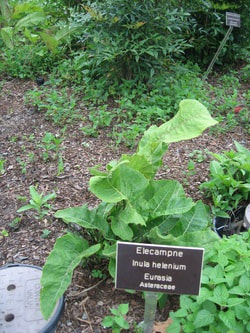
Pushkaramula is the Sanskrita name for Elecampane. This same name is sometimes given to herbs in the Costus genus of the ginger family. The India Species of Elecampane is Inula racemosa. We have the Western species (Inula helenium) at the garden. Its properties are very similar to those of the Indian species. The two species may be used more or less interchangeably. The Sanksrit name Pushkaramula is generally used to refer to all members of the Inula genus.
Pushkaramula is used mainly for its expectorant qualities. It increases digestion, and deepens prana (the breath / life force). Along with vasaka, and pippali it is once of the best pugent expectorants in Ayurveda for the lings. It is a good heart tonic for vata and pitta, but may increase pitta. It also helps to lower blood pressure for Vaata and Kapha. It may be used to treat high cholesterol and menstrual problems. A good lung tonic for vata and kapha can be made from equal parts of tulasi, pushkarmula, pippali, licorice, aniseed.
Pushkaramula is used mainly for its expectorant qualities. It increases digestion, and deepens prana (the breath / life force). Along with vasaka, and pippali it is once of the best pugent expectorants in Ayurveda for the lings. It is a good heart tonic for vata and pitta, but may increase pitta. It also helps to lower blood pressure for Vaata and Kapha. It may be used to treat high cholesterol and menstrual problems. A good lung tonic for vata and kapha can be made from equal parts of tulasi, pushkarmula, pippali, licorice, aniseed.